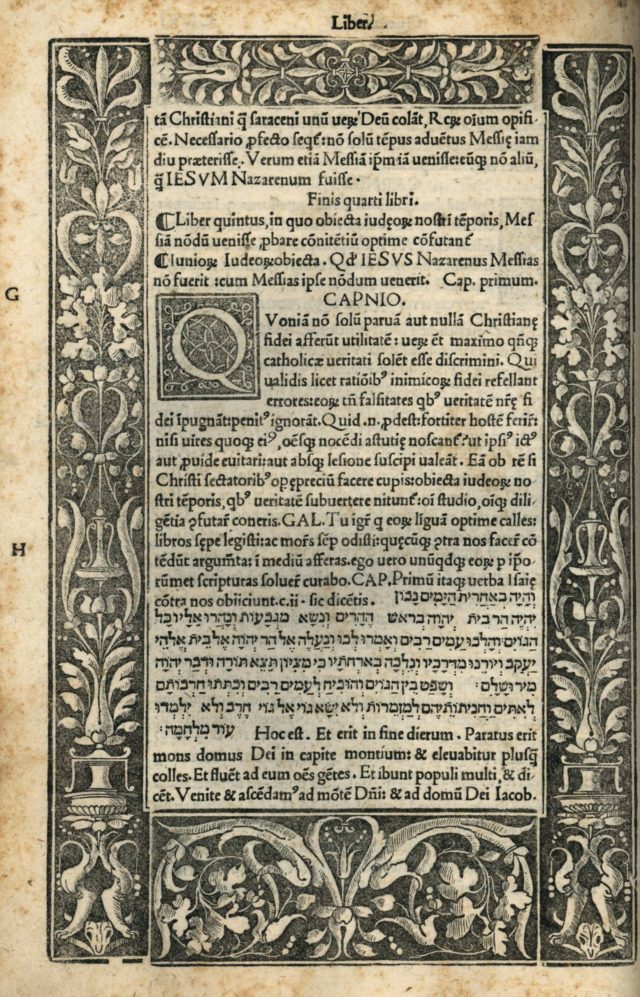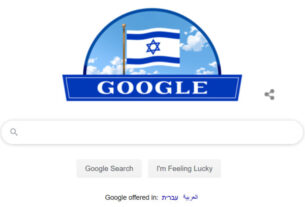A book titled “Anti-Jewish Essay” written by Pietro Galatino, a well-known anti-Semitic priest was printed by no other but Gershom Ben Moshe, a member of the distinguished Jewish family Soncino who lived in Italy during the early 16th century.
Why Rev. Pietro Galatino choose to print his book at a Jewish print house, and why the Jewish family agreed to print his anti-semic book?
The Soncino family was a famous family in the world of Jewish literature and beyond. Gershom’s grandfather set up the first Hebrew printing house in the city of Soncino, located in northern Italy.
The family was the first to print the Bible in Hebrew. They also printed tractates from the Mishnah and the Gemara, Passover Haggadah, prayer books and eventually books of Jewish law, mysticism and philosophy as well.
The books contain the hallmark characteristics typical of books printed by Soncino, such as the addition of an illustration with a woodcut border at the beginning of each chapter.
Over the years, Gershom became the central worker of the family printing house. He traveled all over Europe in search of manuscripts that can be printed. He later enhanced his means and began to carry a mobile printing machine with him on his travels.
The “Anti-Jewish Essay” (printed in 1518) was the first of three he printed in the city of Ortona, but the only one with a distinctly anti-Semitic character.
Gershom also visited all over the Savoy region in Switzerland, Italy, and France. It is also known that he spoke Greek and Latin in addition to Hebrew and the local language, which helped him in his work.
The printing of “Anti-Jewish Essay” comes as a surprise because the history of the Jewish people in Italy during Galatino’s time indicates the presence of a significant polemic that was enacted by the Holy Roman Empire against Jewish books and the Jewish people.
Jewish books and in particular the Talmud, were blamed as being the “source of all evil,” and Holy Roman Emperor Maximilian I eventually ordered the confiscation of Jewish books.
Several German scholars protested the policy due to their insistence that Jewish texts contain Christian truths, and as a result, the order was rescinded.
The book, in fact, was written to demonstrate Christian “truths” from Jewish literature. Despite the writer’s identity, the Soncino family printed the book in its own language perhaps to depict the legitimacy attributed to Jewish books by Christian scholars at the time.
Included among the book’s pages are many verses from Jewish texts in a most apparent attempt to prove that Jewish writings serve as the bases of the Christian faith, thus establishing a connection between the writer’s glorification of Christianity and the rationale for printing a work containing Jewish writings.
The book is part of a private collection belonging to Rabbi Daniel Sperber, a scholar in Talmud and Judaism as well as a professor emeritus at Bar Ilan University, that has been transferred to Jerusalem’s Kedem Auction House and up for sale in the next few days.
Meron Eren, co-founder of the Kedem Auction House, said: “Soncino, to our understanding, did all that he could to empower Jewish literature without letting anything stand in his way. I am certain that the order during Galatino’s time to confiscate Jewish books served to be a primary factor convincing Soncino to print a book written by a well-known anti-Semite. This story also helps to inform the public of a historic phenomenon in which passionate anti-Semites attributed importance and legitimacy to various Jewish works and writings.”
Read more about: anti-Semitic books




